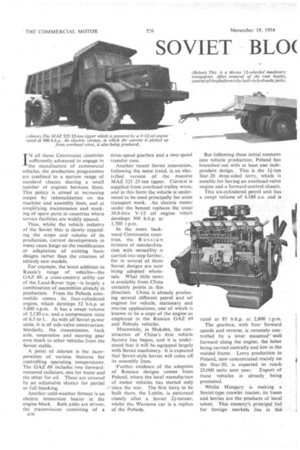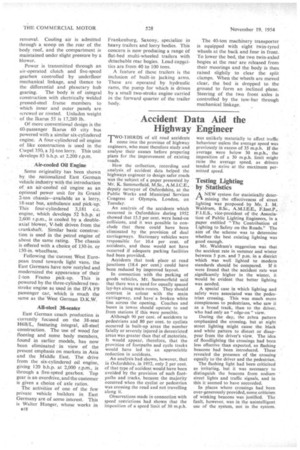SOVIET BL0( STANDARDIZES DESIGNS
Page 50

Page 51

Page 52

If you've noticed an error in this article please click here to report it so we can fix it.
By David Scott
iN all those Communist countries sufficiently .advanced to engage in the manufacture of commercial vehicles, the production programmes are confined to a narrow range of standard chassis sharing . a small number of engines between them. This policy is aimed at increasing output by rationalization on the machine and assembly lines, and at simplifying maintenance and stocking of spare parts in countries where service facilities are widely spaced.
Thus, whilst the vehicle industry of the Soviet bloc is slowly expanding the scope and volume of its production, current developments in many cases hinge on the modification or adaptation of existing basic designs rather than the creation of entirely new models.
For example, the latest addition to Russia's range of vehicles—the GAZ 69, a cross-country utility car of the Land-Rover type—is largely a combination of assemblies already in production. From the Pobeda automobile comes its _four-cylindered engine, which develops 52 b.h.p. at 3,600 r.p.m. It has a swept volume of 2,120 c.c. and a compression ratio of 6.5 to 1. As with all-Soviet power units, it is of side-valve construction. Similarly, the transmission, back axle, suspension and steering gear owe much to other vehicles from the Soviet stable..
A point of interest is the incorporation of various features for controlling operating temperatures. The GAZ 69 includes two forwardmounted radiators, one for water and the other for oil. These are covered by an adjustable shutter for partial or full blanking.
Another cold-weather fitment is an electric immersion heater in the engine block. Both axles are driven, the transmission consisting of a 1316 three-speed gearbox and a two-speed transfer cast. • Another recent Soviet innovation, following the same trend, is an electrified version of the massive MAZ 525 25-ton tipper. Current is supplied from overhead trolley wires, and in this form the vehicle is understood to he used principally for mine transport work. An electric motor under the bonnet replaces the usual 38.8-litre Y-12' oil engine which develops 300 b.h.p. at 1,700 r.p.m.
In the more backward Communist countries, the Russia rs mixture of standardization with versatility is carried one step further, for in several of them Soviet. designs are now being adopted" wholesale. What little news is available from China certainly points in this direction. China is already producing several different petrol and oil engines for vehicle, stationary and marine applications, one of which is known to be a copy of the engine as employed in the Russian GAZ 69 and Pobeda vehicles.
Meanwhile, in Mukden, the construction of China's first vehicle factory has begun, and it is understood that it will be equipped largely with Soviet machinery. It is expected that Soviet-style lorries will come off its assembly lines.
'Further evidence of the adoption of Russian designs comes from Poland, where the local manufacture of motor vehicles has started only "since the war. The first lorry to be built there, the Lublin, is patterned closely after a Soviet 24-tormer, whilst the Warsawa car is a replica of the Potreda. But following these initial ventures into vehicle production, Poland has branched out with at least one independent design. This is the 3i-ton Star-20 drop-sided lorry, which is notable for having an overhead-valve engine and a forward-control chassis.
This six-cylindered petrol unit has a swept volume of 4,188 c.c. and is rated at 85 b.h.p. at, 2,800 r.p.m.
The gearbox, with four forward speeds and reverse, is remotely controlled by a lever mounted well forward along the engine, the latter being carried centrally and low in the welded frame. Lorry production in Poland, now concentrated mainly on the Star-20, is expected to reach 25,000 units next year. Export of these vehicles is already being promoted.
Whilst Hungary is. making a Soviet-type crawler tractor, its buses and lorries are the products of local talent. This Country's prinCipaI ,bid for foreign• rirtark6ts lies in tie (Above, right) The only vehicle entirely built in Hungary is the Csepel 350, a 31-tonner. It is powered by a four-cylindered oil engine of 53-litre capacity, rated at 85 b.h.p. (Left) An outstanding feature of this unit is its exceptionally clean design. It is the oil engine used in the Hungarian Csepel
shown in the illustcation above.
Ikarus 55 rear-engined coach, which was exhibited at the Geneva and Paris Motor Shows this year. Here, Hungary's pre-war experience with' oil engines has been put to good account in the Csepel D163 six-cylindered unit, developing 125 b.h.p. at 2,200 r.p.m.: the compression ratio is 21 to 1. Bore and stroke are 110 mm. and 140 mm., and piston displacement 7,983 c.c.
Wet cylinder liners and individual cylinder heads are used, and there are two cooling radiators.
The engine is carried in a noise-insulated and dustproofed compartment readily accessible for servicing via a pair of full-width wrap-around doors, and is mounted on a sub-frame for easy removal. Cooling air is admitted through a scoop on the rear of the body roof, and the compartment is maintained under slight pressure by a blower.
Power is transmitted through an air-operated clutch and five-speed gearbox controlled by underfloor mechanical linkage, and thence to the differential and planetary hub gearing. The body is of integral construction with electrically Welded pressed-steel frame members to which inner and outer panels are screwed or riveted. Unladen weight of the Ikarus 55 is 17,280 lb.
Of more conventional design is the 60-passenger Ikarus 60 city bus powered with a similar six-cylindered engine. A four-cylindered oil engine of like construction is used in the Csepel 350, a 3i-ton lorry. This unit develops 85 b.h.p. at 2,200 r.p.m.
. Air-cooled Oil Engine _ Some originality has been shown by the .nationalized East . German vehicle industry with the introduction of an air-cooled oil 'engine as an optional power unit for its Granit 2-ton chassis—available as 'a. lorry, 18-seat bus, ambulance arid Pick-up: This four-cylindered 3,181 c.c. engine, which develops 52 b.h.p. at 2,600 r.p.m., is cooled by a doubleaxial blower, V-belt driven from the crankshaft. Similar basic construction is used in the petrol engine of about the same rating. The chassis is offered with a choice of 130-in. or 150-in. wheelbase.
Following the current West European trend towards light vans, the East Germans have now restyled and modernized the appearance 'of their i-ton Frain° pick-up. This is powered by the three-cylindered twostroke engine as used in the IFA F9 passenger car, which is much the same as the WestGerman D.K.W.
All-steel 38-seater
East German coach production is currently focused on the 38-seat H6B/L, featuring integral, all-steel construction. The use of wood for flooring and some body members, found in earlier models, has now been eliminated in view of the present emphasis on markets in Asia and the Middle East. The drive from the six-cylindered oil engine, giving 120 b.h.p. at 2,000 r.p.m., is through a five-speed gearbox. Top gear is an overdrive, and the customer is given a choice of axle ratios.
The activities of one of the few private vehicle builders in East Germany are of some interest. This is Walter Hunger, whose works in s18 Frankenburg, Saxony, specialize in heavy trailers and lorry bodies. This concern is now producing a range of flat-bed multi-wheeled trailers with detachable rear bogies. Load capacities are from 40 to 100 tons.
A feature of these trailers is the inclusion of built-in jacking arms. These are operated by hydraulic rams, the pump for which is driven by a small two-stroke engine carried in the forward quarter of the trailer body.
The 40-ton machinery transporter is equipped with eight twin-tyred wheels at the back and four in front. To lower the bed, the two twin-axled bogies at the rear are released from their moorings and the body is then raised slightly to clear the split clamps. When the wheels are moved clear, the -bed is dropped to the ground to form an inclined plane. Steering of the two front axles is controlled by the tow-bar through mechanical linkage.




































































































